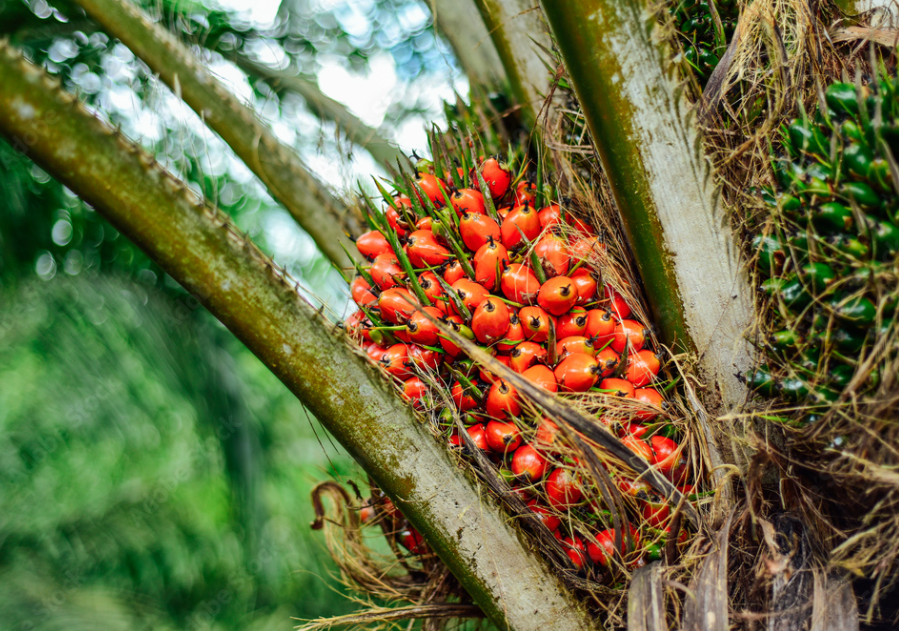Origin Of palm Fruit
Palm fruit, sometimes called African oil palm, is a species of palm with the botanical name Elaeis guineensis. Oil palm is the main source of palm oil. It is indigenous to west and southwest Africa, Angola and The Gambia. The botanical name guineensis was the former name of The Gambia.
Palm trees are single-stemmed, and the mature ones grow up to 20 meters tall. The leaves are 3-5 meters long and alternate with each other. Immature palms produce about 30 leaves annually, while the palm of over ten years has about 20 leaves.
The fruits are reddish, and they grow in large bunches. Each fruit consists of an oily, fleshy outer layer (the pericarp) with a single seed (the palm kernel). The fruit is rich in oil.
Nutrient Composition Of palm Fruit
The following are the nutrient content in 100g of palm oil:
- Calories 884
- Total Fat 100 g
- Saturated fat 49 g
- Polyunsaturated fat 9 g
- Monounsaturated fat 37 g
- Total Carbohydrate 0 g
- Dietary fibre 0 g
- Sugar 0 g
Preferred Botanical Name: Elaeis guineensis
Preferred Common Name: Palm fruit, Oil palm
Local Common Name:
- Ibibio: Isip eyop
Medicinal Benefits And Uses Of Palm Fruit
Palm fruit has several health benefits, which are listed and explained below.
- Tocotrienols, a form of vitamin E, are present in Palm oil. Tocotrienols have strong antioxidant properties that support brain health.
- Palm oil is known to protect against heart disease.
- People who are deficient or at risk of vitamin A deficiency can eat or include palm fruit in their diet to improve their vitamin A status.
How To Grow Palm Fruit
The following are detailed explanations of how to grow palm fruit.
Yield Information Of Palm Fruit
It takes about 5-6 months for palm fruits to develop from pollination to maturity. Depending on the age of the palm tree, a bunch of fruit weighs between 5 and 30 kg (11 to 66 l b). One tree can produce between four and ten bunches of fruits.
A yield of 8 to 10 tones per hectare is expected during the initial period of 4 to 8 years. After eight years, 18 to 20 tones per hectare can be expected.
Soil And Sun Requirements Of Palm Fruits
Oil palm is grown on many soil types, but soils with moderate to high fertility are favored, well-drained, deep loamy, moist soil rich in organic matter. They require at least 1-meter soil depth.
Nursery And Transplant Requirements Of Palm Fruits
For the nursery, the single-stage polybag system is a very popular propagation method, and the bags are filled with topsoil, sand and well rotted manure; then, you should place sprouts at a depth of 2.5cm in the center of the polybag. Regular watering is carried out to ensure proper growth.
Watering Requirements Of Palm Fruits
Watering once every few days is usually adequate. Frequent watering is required during hot and dry weather. Palm fruits require annual rainfall of 2500 to 4000 mm. Ensure that you do not overwater the plant, which may dampen the new leaves and cause rot problems.
Planting And Spacing Requirements Of Palm Fruit
A rectangular planting method is recommended in oil palm cultivation, spacing 9 meters by 9 meters by 9 meters. A hectare of land can accommodate One hundred forty-five oil plants.
Harvesting Of Palm Fruit
The oil palm will be ready for harvesting 2 to 3 years after plantation in the main field. Harvesting can be done when fruits on the palm turn yellowish-orange color. It is harvested with the help of a sharp knife or sickle.
Storage Of Palm Fruit
Keep palm fruit in a cool, dry place to avoid it from becoming too clumsy. Storing it at a 20-25 degrees temperature and in the dark can increase its shelf life to a few months.
Diseases And Pests Of Palm Fruit
Bacterial Bud Rot
Parts of spear leaf petiole turn brown, leaves collapsing, death of the palm. It is a bacterial disease. Plant oil palm resistant varieties and remove already rotting parts on leaves.
Ganoderma butt rot
Reduced palm growth, leaves turn chlorotic, discolouration on the trunk. It is caused by fungi. It is controlled by removing infected trees and not replanting in the soil where the affected tree was.
Mealybugs
The insect attracts ants and causes the growth of sooty mold. It can be controlled by using natural enemies like lady beetles.
Conclusion
Palm fruit offers a myriad of health benefits. Rich in antioxidants, it supports heart health by reducing cholesterol levels and improving blood circulation. The fruit contains vitamins A and C, promoting vision and boosting the immune system. Its high fiber content aids digestion and helps maintain a healthy weight. Additionally, palm fruit possesses anti-inflammatory properties and contributes to skin health, combating signs of aging
Incorporating palm fruit into your diet is a smart choice for improving your overall well-being. Packed with a variety of essential nutrients like potassium and magnesium, it helps regulate blood pressure and promotes better muscle function. By including palm fruit in your balanced diet, you can take meaningful steps towards a healthier and more vibrant lifestyle.
